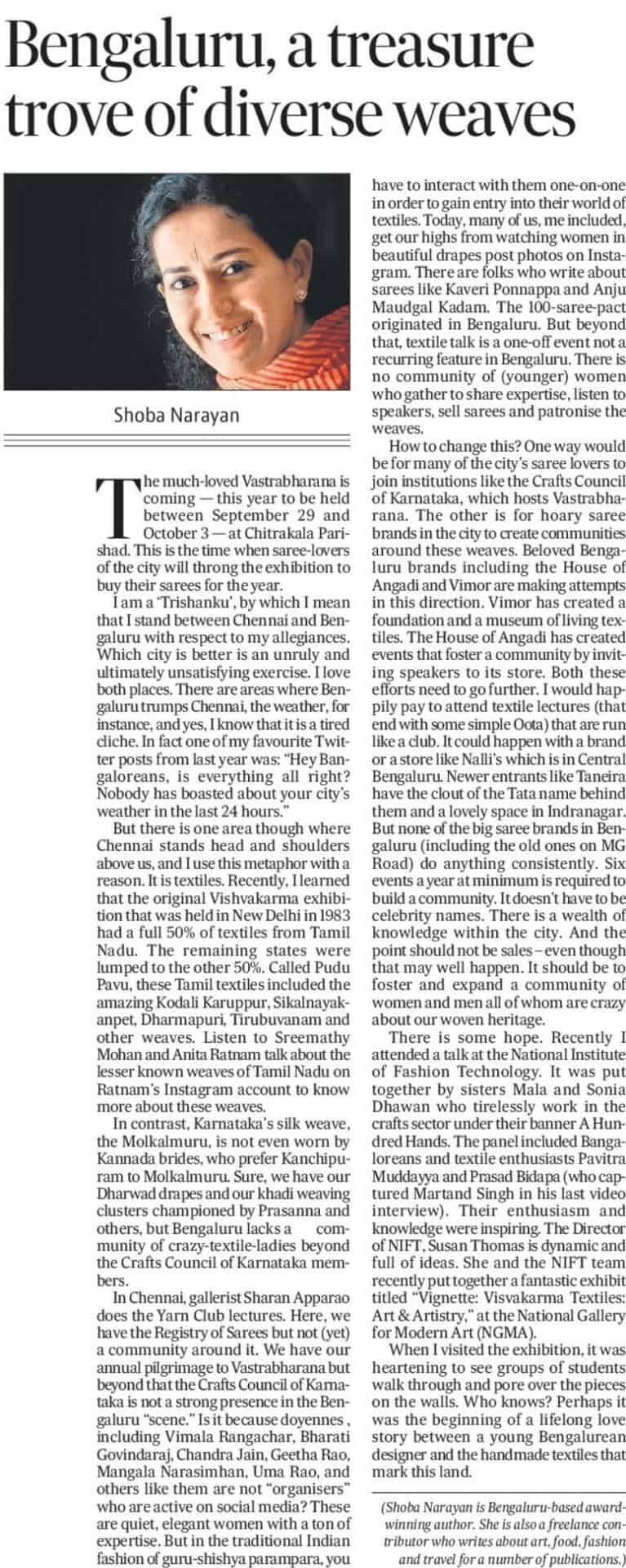The much-loved Vastrabharana is coming– this year between September 29 and October 3rd at Chitrakala Parishad. This is the time when saree-lovers of the city will throng the exhibition to buy their sarees for the year.
I am a trishanku, by which I mean that I stand between Chennai and Bengaluru with respect to my allegiances. Which city is better is an unruly and ultimately unsatisfying exercise. I love both these places. There are areas where Bangalore trumps Chennai, the weather, for instance, and yes, I know that it is a tired cliche. One of my favourite Twitter posts last year was the following: “Hey Bangaloreans, is everything all right? Nobody has boasted about your city’s weather in the last 24 hours.” But there is one area though where Chennai stands head and shoulders above us, and I use this metaphor with reason. It is textiles.

How to change this? One way would be for many of the city’s saree lovers to join institutions like the Crafts Council of Karnataka, which hosts Vastrabharana. The other is for hoary saree brands in the city to create communities around these weaves. Beloved Bengaluru brands including the House of Angadi and Vimor are making attempts in this direction. Vimor has created a foundation and a museum of living textiles. The House of Angadi has created events that foster a community by inviting speakers to its store. Both these efforts need to go further.
I would happily pay to attend textile lectures (that end with some simple Oota) that are run like a club. It could happen with a brand or a store like Nalli’s which is in Central Bengaluru. Newer entrants like Taneira have the clout of the Tata name behind them and a lovely space in Indranagar. But none of the big saree brands in Bengaluru (including the old ones on MG Road) do anything consistently.
Six events a year at minimum is required to build a community. It doesn’t have to be celebrity names. There is a wealth of knowledge within the city. And the point should not be sales – even though that may well happen. It should be to foster and expand a community of women and men all of whom are crazy about our woven heritage.
There is some hope. Recently I attended a talk at the National Institute of Fashion Technology. It was put together by sisters Mala and Sonia Dhawan who tirelessly work in the crafts sector under their banner A Hundred Hands. The panel included Bangaloreans and textile enthusiasts Pavitra Muddayya and Prasad Bidapa (who captured Martand Singh in his last video interview). Their enthusiasm and knowledge were inspiring.
The Director of NIFT, Susan Thomas is dynamic and full of ideas. She and the NIFT team recently put together a fantastic exhibit titled “Vignette: Visvakarma Textiles: Art & Artistry,” at the National Gallery for Modern Art (NGMA).
When I visited the exhibition, it was heartening to see groups of students walk through and pore over the pieces on the walls. Who knows? Perhaps it was the beginning of a lifelong love story between a young Bengalurean designer and the handmade textiles that mark this land.




Leave A Comment